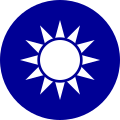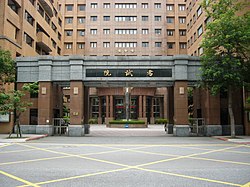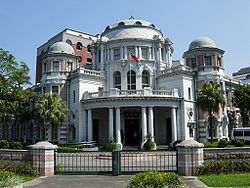Government of the Republic of China
Free area) | |
| Website | taiwan |
|---|---|
| Legislative branch | |
| Legislature |
|
| Meeting place | Legislative Yuan Building, Taipei |
| Executive branch | |
| Leader | Premier |
| Appointer | nominated by the president |
| Main organ | Executive Yuan |
| Departments | 35 |
| Judicial branch | |
| Court | Judicial Yuan |
| Seat | Taipei |
 |
|---|
|
|
| Government of the Republic of China | |
|---|---|
BUC | Dṳ̆ng-huà Mìng-guók Céng-hū |
The Government of the Republic of China,
Originally established in 1912 in
.Organizational structure
The government formally consists of the presidency and five branches of government, modeled on Sun Yat-sen's political philosophy of Three Principles of the People.
| Office of the President | President | National Security Council | |||||||||||||||||||||||||||||||||||||
| Executive Yuan | Legislative Yuan | Judicial Yuan | Examination Yuan | Control Yuan | |||||||||||||||||||||||||||||||||||
In practice, the system resembles a
| Category | Name | Role | Leader | |||
|---|---|---|---|---|---|---|
| English | Chinese
| |||||
| Presidency | President | 總統 | Head of state, Executive | Lai Ching‑te
|

| |
| Vice President | 副總統 | Hsiao Bi-khim | 
| |||
| Office of the President | 總統府 | Advisory and administrative agencies to the President |
Pan Men-an | 
| ||
| National Security Council | 國家安全會議 | Joseph Wu | 
| |||
| Five Yuans | Executive Yuan | 行政院 | Executive, Cabinet | Cho Jung-tai | 
| |
| Legislative Yuan | 立法院 | Legislature, Parliament | Han Kuo-yu | 
| ||
| Judicial Yuan | 司法院 | Judiciary, Constitutional court | Shieh Ming-yan (acting) | 
| ||
| Examination Yuan | 考試院 | Civil service commission | Chou Hung-hsien | 
| ||
| Control Yuan | 監察院 | Auditory | Chen Chu | 
| ||
Presidency
The leadership of the country consists of the two top officials that is directly and jointly elected by citizens of the Republic of China residing in the
Under the president, two advisory and administrative agencies are established to support the work of the president.
- Office of the President (Presidential Office)
- Secretary-General of the Office of the President
- National Security Council
- Secretary-General of the National Security Council
Executive Yuan

The Executive Yuan is led by the premier. However, the ROC's political system does not fit traditional models. The premier is selected by the president without the need for approval from the Legislature, but the Legislature can pass laws without regard for the president, as neither the president nor the premier wields veto power. Thus, there is little incentive for the president and the legislature to negotiate on legislation if they are of opposing parties. During the tenure of the pan-Green's Chen Shui-bian the continued control of the Legislative Yuan by the pan-Blue majority caused legislation to repeatedly stall, as the two sides were deadlocked. There is another curiosity of the ROC system; because the ROC was previously dominated by strongman one-party politics, real power in the system shifted from one position to another, depending on what position was currently occupied by the leader of the state (Chiang Kai-shek and later his son, Chiang Ching-kuo). This legacy has resulted in executive powers currently being concentrated in the office of the president rather than the premier.
Legislative Yuan

The main
Judicial Yuan

The Judicial Yuan is the ROC's highest
Capital punishment is legal. Efforts have been made by the government to reduce the number of executions, although they have not been able to completely abolish the punishment. As of 2006, about 80% of Taiwanese want to keep the death penalty.[2]
Examination Yuan

The Examination Yuan is in charge of validating the qualification of civil servants in the Republic of China. As a special branch of government under the Three Principles of the People. The concept of the Examination Yuan is based on the old Imperial examination system used in Imperial China.
Control Yuan

Based on the traditional Chinese
History
The Government of the Republic of China was formally established in 1912 in
1912–1928

The first Chinese national government was established on 1 January 1912, in Nanjing, with Sun Yat-sen as the provisional president. Provincial delegates were sent to confirm the authority of the national government, and they later also formed the first parliament. The power of this national government was limited and short-lived, with generals controlling both central and northern
When Yuan died, the parliament of 1913 was reconvened to give legitimacy to a new government. However, the real power of the time passed to military leaders, forming the warlord period. The impotent government still had its uses; when World War I began, several Western powers and Japan wanted China to declare war on Germany, in order to liquidate German holdings. Nevertheless, it was widely seen as weak and unstable.
There were also several warlord governments and puppet states sharing the same name. See also:
1928–1949

After the successful
Known as the
With the outbreak of the Second Sino-Japanese War, the invading Imperial Japanese Army managed to capture Nanjing on 13 December 1937. The Japanese then proceeded to sack the city, and massacred hundreds of thousands of Chinese civilians. With the fall of Nanjing, the government was forced to move first to Wuhan, until the city fell on 27 October 1938. It retreated further inland to Chongqing, which was the wartime capital until 1945. Although Chongqing was located in the inland western province of Sichuan, it was nevertheless heavily bombed by Japanese warplanes many times during the course of the war.
With the end of the war, the National Government moved back to Nanjing. The Kuomintang then proceeded with the drafting of a new constitution for China, which were boycotted by the communists. The
However, in 1946, the
With the fall of Nanjing to the PLA in April 1949, the ROC government moved south to Guangzhou, and then to its wartime capital of Chongqing, and finally to Chengdu. Sensing that he would eventually lose the mainland to the communists, Chiang secretly started preparations to move the government to the island of Taiwan, which was placed under the ROC's control on 25 October 1945. Taiwan was seen as a safe haven for Chiang due to it being separated from the mainland by the 180 km or 110 mi-wide Taiwan Strait. During that period, more than two million civilians, military personnel and government officials left the mainland for Taiwan. Chiang then declared Taipei as the provisional capital of the Republic of China on 7 December 1949, and left Chengdu for Taipei by air three days later when the city fell to the communists.
Since 1949

Based on the Constitution of the Republic of China, the head of state is the president, who is elected by popular vote for a four-year term on the same ticket as the vice-president. The president has authority over the five administrative branches (Yuan): the Control, Examination, Executive, Judicial, and Legislative Yuans. The president appoints the members of the Executive Yuan as the cabinet, including a premier, who is officially the president of the Executive Yuan; members are responsible for policy and administration.
Originally, the
Amending the ROC constitution now requires the approval of three-fourths of the quorum of members of the Legislative Yuan. This quorum requires at least three-fourths of all members of the Legislature. After passing by the legislature, the amendment needs ratification in a referendum from at least fifty percent of all eligible voters of the ROC regardless of voter turnout.
See also
Notes
References
- ^ "Rome and Peking in Accord on Ties". The New York Times. 7 November 1970. Archived from the original on 7 December 2017. Retrieved 25 August 2020.
- ^ Chang, Rich (2006-01-02). "Nation keeps death penalty, but reduces executions". Taipei Times. Archived from the original on 2019-02-23. Retrieved 2009-11-02.
- ^ Ch'ien Tuan-Sheng (Qian Duansheng)The Government and Politics of China, 1912-1949. (Cambridge, MA: Harvard University Press, 1950).

